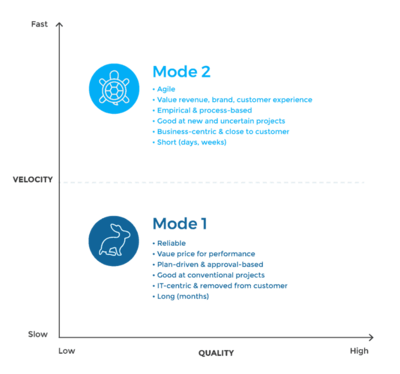Bimodal IT
Bimodal IT is a type of strategy or setup where a single IT department is split up into two parts – one part addresses maintenance and support issues, while another part pursues innovation and expansion. Bimodal IT helps companies to keep up with these two very different responsibilities in a more direct way than by trying to delegate both within one IT department.[1]
The concept of Bimodal IT was introduced by the IT firm Gartner who defines Bimodal IT as "the practice of managing two separate but coherent styles of work: one focused on predictability; the other on exploration. Mode 1 is optimized for areas that are more predictable and well-understood. It focuses on exploiting what is known, while renovating the legacy environment into a state that is fit for a digital world. Mode 2 is exploratory, experimenting to solve new problems and optimized for areas of uncertainty. These initiatives often begin with a hypothesis that is tested and adapted during a process involving short iterations, potentially adopting a minimum viable product (MVP) approach. Both modes are essential to create substantial value and drive significant organizational change, and neither is static. Marrying a more predictable evolution of products and technologies (Mode 1) with the new and innovative (Mode 2) is the essence of an enterprise bimodal capability. Both play an essential role in digital transformation."[2]
Bimodal IT - Mode 1 and Mode 2[3]
Bimodal is the practice of managing two separate but coherent styles of work: one focused on predictability; the other on exploration. Marrying a more predictable evolution of products and technologies (Mode 1) with the new and innovative (Mode 2) is the essence of an enterprise bimodal capability.
- Mode 1 Is Predictable: The current mode, Mode 1, is optimized for predictability and well-defined areas. When doing software development using Mode 1, one needs a clear understanding of the requirements up front, as Mode 1 aims to deliver predictable and precise results. Many highly regulated industries rely on Mode 1 software development methodologies, such as waterfall or spiral. Systems supporting the finance, defense, and pharmaceutical industries operate in Mode 1 for most system development.
- Mode 2 Handles Uncertainty: Mode 2 development is exploratory. It allows experimenting to solve new problems. It’s also optimized for areas of uncertainty. These initiatives often begin with a hypothesis that’s tested quickly. When the test results are good, they’re implemented in short iterations. Mode 2 is called agile because it allows for software requirements to change as the software development progresses. It’s a more fluid process that can respond quickly to pressures from the market and development efforts. This approach introduces additional risk and uncertainty, but it provides a quicker time to market.

